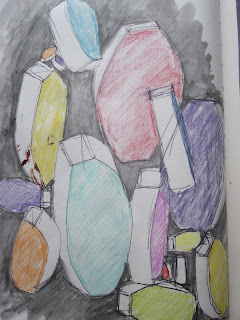References:
1. Barnes Rachel (2003), “Artists in Profile – Abstract Expressionists”, Heinemann Library.
2. Cowling, E et al (2003), “Matisse Picasso”, Tate Publishing.
3. Gombrich, E.H. (1995), “The Storey of Art, 16th Ed.”, Phaidon Press Ltd.
4. Hedge, S (2009), “How to Survive Modern Art”, Tate Publishing.
5. Kudielka, R (2002), “Paul Klee –The Nature of Creation (Works 1914 – 1940), Hayward Gallery.
6. Van Vliet, R (2008), “Painting Abstracts – Ideas, projects and techniques”, Search Press.
I addeded a selection of readily available images from a range of my own visits to exhibitions into my sketchbook as aids to my memory and for quick visual reference.
I experimented with some techniques employed by other artists in my sketchbook e.g. Gerhard Richter's paint dragging approach.
At one extreme my experimentation explored the behaviour of different paints e.g. household paint and acrylic paint mixed with a tar gel medium. Letting the paint drip, dribble and be dragged across the surface of a support created a Jackson Pollock type effect for my "moving lights" expressive study.
At the other extreme I used solid man made objects (i.e. sculptures I had made previously in a life class) set in a garden setting as inspiration for exploring abstraction. Working with photographic images glued into my sketchbook, I played with enhancing elements or features.
Inspired initially by Partick Caulfield's "Study of Pottery, 1969", my abstracted pattern evloved to fill the page and became rendered in different blocks of colour.
By taking my sculpture "little George" on an adventure around my garden, planting began to contextualise the abstracted object. Using an abstract pattern to represent planting and removing textural detail by over painting the image of "little George", the outcome reminded me of an image of Anthony Gormley's exhibit "One and Other (2001)" displayed in the Yorkshire Sculpture Park.
By taking my sculpture "little George" on an adventure around my garden, planting began to contextualise the abstracted object. Using an abstract pattern to represent planting and removing textural detail by over painting the image of "little George", the outcome reminded me of an image of Anthony Gormley's exhibit "One and Other (2001)" displayed in the Yorkshire Sculpture Park.
Referring back to Picasso's work I tried abstracting the image of the sculpture using a series of straight lines.
I found this later abstraction process somewhat mechanical and forced. My preference was the develoment of pattern like random shapes and serendipitous mark making using the properties of the paint medium and associated support material. I also found it interesting working with colour in an expressive manner in these abstract studies rather than being held to reproducing true to life hues. I have found that by taking an image for a walk around a page of my sketchbook quite refreshing and a good way to explore an image I may be working on to revitalise my approach. This happend during the production of my final painting for the themed series i.e.
Now that I have a better understanding of abstract art and the process of abstraction, I am more conscious of the range of approaches by different artists. I have increased my interest in this approach to working and seek out exhibitions of artists work I have not come across before (e.g. Saloua Raoda Choucair and Ibrahim El-Salahi) so that I can contiue to grow my understanding and find alternative sources for inspiration.
Now that I have a better understanding of abstract art and the process of abstraction, I am more conscious of the range of approaches by different artists. I have increased my interest in this approach to working and seek out exhibitions of artists work I have not come across before (e.g. Saloua Raoda Choucair and Ibrahim El-Salahi) so that I can contiue to grow my understanding and find alternative sources for inspiration.

























































